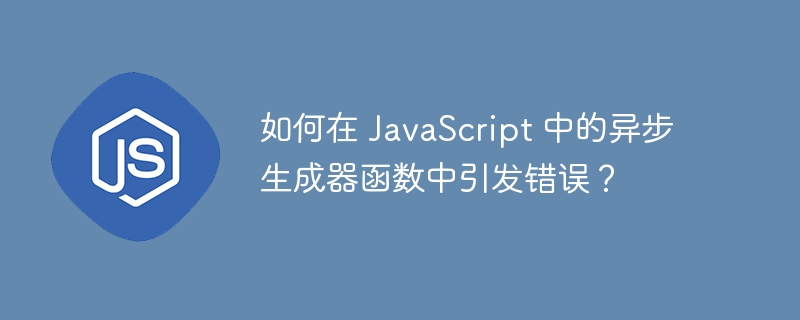如何在 JavaScript 中的异步生成器函数中引发错误?

代码经常会抛出错误,处理错误更为重要。 JavaScript 还允许用户使用“throw”关键字抛出自定义错误。我们可以在 catch 块中捕获错误。
我们可以使用 try-catch 语法来捕获普通函数抛出的错误。让我们通过下面的例子来理解它。
示例 1(在正则函数中抛出错误)
在下面的示例中,我们创建了 throwError() 常规函数,该函数使用 throw 关键字抛出带有自定义错误消息的错误。我们已经执行了 try 块内的函数。如果函数抛出任何错误,控件将转到 catch 块,这就是我们检测错误的方式。
<html>
<body>
<h3> Using the throw keyword to throw an error from the normal function </h3>
<div id = "content"> </div>
<script>
let content = document.getElementById('content');
// throw error from normal function
function throwError() {
throw new Error('Error from normal function');
}
try {
throwError();
} catch (e) {
content.innerHTML = e;
}
</script>
</body>
</html>
如果我们将 throwError() 函数设为异步,它将生成另一个错误,因为我们可以使用 try-catch 块来处理同步函数抛出的错误。
要解决该问题,用户必须使用 then-catch 块语法来解决承诺。
语法
用户可以按照以下语法来解决异步函数抛出的错误。
throwError().then((res) => {
// print content
}).catch((err) => {
// print error message
})
在上面的语法中, throwError() 是一个返回 Promise 的函数,我们使用 then 和 catch 块来解决这个问题。
示例 2(异步函数引发错误)
在下面的示例中, throwError() 函数是一个异步函数,因为我们在 function 关键字之前添加了“async”关键字。我们从异步函数中抛出了错误,就像从常规函数中抛出错误一样。
之后,我们使用 then 和 catch 块处理 Promise。在输出中,用户可以观察到,当异步函数抛出错误时,控制权转到 catch 块。
<html>
<body>
<h3> Using the <i> throw </i> keyword to throw an error from the async function </h3>
<div id = "content"> </div>
<script>
let content = document.getElementById('content');
// throw error from normal function
async function throwError() {
throw new Error('Error from Async function');
}
throwError().then((res) => {
content.innerHTML = res;
}).catch((err) => {
content.innerHTML = err;
})
</script>
</body>
</html>
示例 3(通过在异步函数中拒绝 Promise 抛出错误)
我们可以从异步函数返回承诺。异步函数中的拒绝承诺就像抛出错误一样。我们在回调函数中使用了reject()方法来拒绝promise。
‘then-catch’块用于解析函数返回的promise,用户可以看到控件转到catch块。
<html>
<body>
<h3> Using the <i> reject </i> method to throw an error from the async function </h3>
<div id = "content"> </div>
<script>
let content = document.getElementById('content');
// throw error from normal function
async function throwError() {
return new Promise((resolve, reject) => {
reject("This promise is rejected from the async function." );
});
}
throwError().then((res) => {
content.innerHTML = res;
}).catch((err) => {
content.innerHTML = err;
})
</script>
</body>
</html>
用户学会了如何从异步函数中抛出错误。用户可以像常规函数一样使用“throw”关键字来抛出错误。用户需要使用“then-catch”块来处理错误,因为异步函数返回 Promise,而不是使用 try-catch 块来处理。
以上是如何在 JavaScript 中的异步生成器函数中引发错误?的详细内容。更多信息请关注PHP中文网其他相关文章!

热AI工具

Undresser.AI Undress
人工智能驱动的应用程序,用于创建逼真的裸体照片

AI Clothes Remover
用于从照片中去除衣服的在线人工智能工具。

Undress AI Tool
免费脱衣服图片

Clothoff.io
AI脱衣机

Video Face Swap
使用我们完全免费的人工智能换脸工具轻松在任何视频中换脸!

热门文章

热工具

记事本++7.3.1
好用且免费的代码编辑器

SublimeText3汉化版
中文版,非常好用

禅工作室 13.0.1
功能强大的PHP集成开发环境

Dreamweaver CS6
视觉化网页开发工具

SublimeText3 Mac版
神级代码编辑软件(SublimeText3)

热门话题
 7652
7652
 15
15
 1392
1392
 52
52
 91
91
 11
11
 73
73
 19
19
 37
37
 110
110
 谁得到更多的Python或JavaScript?
Apr 04, 2025 am 12:09 AM
谁得到更多的Python或JavaScript?
Apr 04, 2025 am 12:09 AM
Python和JavaScript开发者的薪资没有绝对的高低,具体取决于技能和行业需求。1.Python在数据科学和机器学习领域可能薪资更高。2.JavaScript在前端和全栈开发中需求大,薪资也可观。3.影响因素包括经验、地理位置、公司规模和特定技能。
 神秘的JavaScript:它的作用以及为什么重要
Apr 09, 2025 am 12:07 AM
神秘的JavaScript:它的作用以及为什么重要
Apr 09, 2025 am 12:07 AM
JavaScript是现代Web开发的基石,它的主要功能包括事件驱动编程、动态内容生成和异步编程。1)事件驱动编程允许网页根据用户操作动态变化。2)动态内容生成使得页面内容可以根据条件调整。3)异步编程确保用户界面不被阻塞。JavaScript广泛应用于网页交互、单页面应用和服务器端开发,极大地提升了用户体验和跨平台开发的灵活性。
 如何使用JavaScript将具有相同ID的数组元素合并到一个对象中?
Apr 04, 2025 pm 05:09 PM
如何使用JavaScript将具有相同ID的数组元素合并到一个对象中?
Apr 04, 2025 pm 05:09 PM
如何在JavaScript中将具有相同ID的数组元素合并到一个对象中?在处理数据时,我们常常会遇到需要将具有相同ID�...
 如何实现视差滚动和元素动画效果,像资生堂官网那样?
或者:
怎样才能像资生堂官网一样,实现页面滚动伴随的动画效果?
Apr 04, 2025 pm 05:36 PM
如何实现视差滚动和元素动画效果,像资生堂官网那样?
或者:
怎样才能像资生堂官网一样,实现页面滚动伴随的动画效果?
Apr 04, 2025 pm 05:36 PM
实现视差滚动和元素动画效果的探讨本文将探讨如何实现类似资生堂官网(https://www.shiseido.co.jp/sb/wonderland/)中�...
 JavaScript难以学习吗?
Apr 03, 2025 am 12:20 AM
JavaScript难以学习吗?
Apr 03, 2025 am 12:20 AM
学习JavaScript不难,但有挑战。1)理解基础概念如变量、数据类型、函数等。2)掌握异步编程,通过事件循环实现。3)使用DOM操作和Promise处理异步请求。4)避免常见错误,使用调试技巧。5)优化性能,遵循最佳实践。
 console.log输出结果差异:两次调用为何不同?
Apr 04, 2025 pm 05:12 PM
console.log输出结果差异:两次调用为何不同?
Apr 04, 2025 pm 05:12 PM
深入探讨console.log输出差异的根源本文将分析一段代码中console.log函数输出结果的差异,并解释其背后的原因。�...
 前端开发中如何实现类似 VSCode 的面板拖拽调整功能?
Apr 04, 2025 pm 02:06 PM
前端开发中如何实现类似 VSCode 的面板拖拽调整功能?
Apr 04, 2025 pm 02:06 PM
探索前端中类似VSCode的面板拖拽调整功能的实现在前端开发中,如何实现类似于VSCode...





